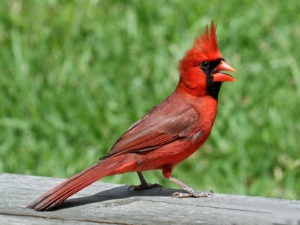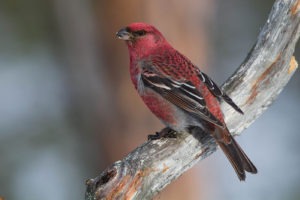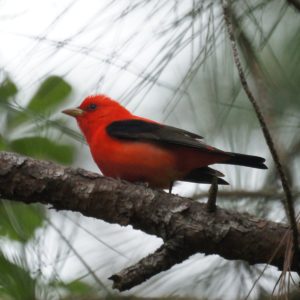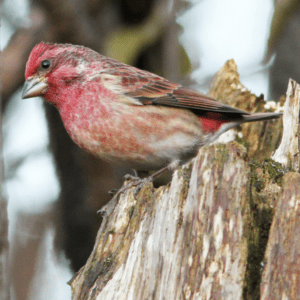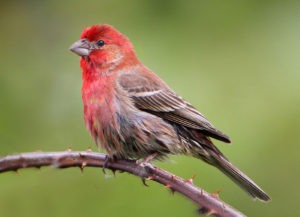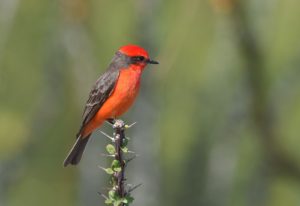Red Sparrow bird or was it just another bird? Well, let’s dive into it! Different types of sparrows make up a sizeable portion of the birds that frequent backyard bird feeders. Sparrows are comfortable in urban and suburban environments, where they fill our neighborhoods with cheerful songs and chirps.
Telling one species of sparrow from another is often quite tricky, even for birding experts. Other small birds, such as some finch species, are also easy to confuse with sparrows.
One particular non-sparrow species, the house finch, is often incorrectly assumed to be a type of sparrow.
If the sparrow-like bird you’re seeing has a substantial amount of red coloring, there’s a good chance that it’s a house finch.
Learning to tell small birds apart is an ambitious goal, but developing an eye for the differences between sparrows and finches is a great place to start.
If you typed “red sparrow bird” into your search bar and ended up here, then we’re happy to help you tackle this topic. Let’s step through a quick primer on red birds, sparrows, finches, and small bird identification, including:
- What are the common red songbird species in North America?
- What are the common types of sparrows?
- How to tell apart sparrows and finches
- All about house finches
- How to tell apart finches and sparrows
Red-Colored Songbird ID Chart
Here’s a look at some birds that feature prominent red coloring.
This list isn’t comprehensive but covers the red-colored birds you’re most likely to see in North America.
Red-Colored Bird | Average Adult Length | Distinguishing Traits |
Northern Cardinal
| 8.5” |
|
Pine grosbeak
| 8.5” |
|
Red-winged blackbird
| 7.25” |
|
Scarlet tanager
| 6.5” |
|
Purple finch
| 6.0” |
|
House finch
| 5.5” |
|
Vermilion flycatcher
| 5.5” |
|
What Are the Common Red Songbird Species in North America?
What’s that red bird you saw? Let’s round up the usual suspects—the most widespread and abundant species that display prominent red coloring.
There are two red bird standouts:
- Northern cardinal
- House finch
We’ll discuss house finches in detail below in a separate section.
Northern cardinals, normally just called cardinals, are in the cardinalis genus of the cardinalidae family. Cardinals are common throughout the eastern half of the US and also exist in a few pockets in western states.
Male cardinals are red all over except for a patch of black around the bill. Aside from coloring, cardinals are recognizable by their crests, the mohawk-like tufts of feathers on the crown of the head.
Female cardinals can be a bit more tricky to recognize since they’re mostly colored brown. Identify females by their black faces, orange bills, and pale red-orange colorings on the wings, tail, and crest.
Cardinals are iconic (they’re the state bird of seven US states) and easily recognized by casual birdwatchers. Thanks to their size and bright coloring, cardinals are unlikely to be confused with sparrows.
In urban and suburban environments, if you see a bird with lots of red coloring, there’s a good chance you’re looking at a house finch or a cardinal. However, there are many other birds that feature some red.
Besides cardinals and house finches, other red-colored birds include:
- Tanagers (scarlet tanager, summer tanager, hepatic tanager)
- Red-winged blackbird
- Pine grosbeak
- Vermilion flycatcher
- Purple finch
- Common redpoll
Check the ID chart above to learn more about a few of these species.
What Are the Common Types of Sparrows?
Sparrows are abundant throughout North America.
Sparrow taxonomy is rather confusing, but the best place to start is with these two groupings:
- Old World sparrows (Passeridae family)
- New World sparrows (Passerelidae family)
Old World sparrows are indigenous to Asia, Africa, and Europe.
The house sparrow is the most familiar Old World sparrow species in North America.

Small numbers were brought to the United States from Europe in the 1800s. Now, the house sparrow is abundant throughout the Americas, commonly regarded as an invasive species or a pest.
House sparrows have streaked brown and black wings and gray breasts. They’re most easily recognized by the color pattern around the head and neck: gray on the crest, brown around the eyes, white cheeks, and a black patch under the bill.
House sparrows are distinct from New World sparrows, belonging to a separate taxonomic family.
New World sparrows are indigenous to the Americas.
There are many New World sparrow species. The most familiar members of this group include:
- Song sparrow
- Chipping sparrow
- White-crowned sparrow
- White-throated sparrow
- Fox sparrow
- Swamp sparrow
- Dark-eyed junco
- Towhees (spotted towhee, eastern towhee)
Most sparrows are small, typically around 5-7” in length. Most of the familiar New World sparrow species have white or grayish bodies and brown wings. Many have brown streaks through the head and body and different shades of brown and gray streaks on the wings.
Juncos and towhees, although they don’t have “sparrow” in their names, are also in the sparrow family.
Along with their unique names, juncos and towhees are colored differently than most sparrows. Juncos have gray or black heads and white bellies, while towhees have black heads and white bellies.
Along with house sparrows, a number of New World sparrow species have learned to thrive in human-filled environments. Song sparrows, juncos, and other sparrows are common visitors to backyard bird feeders.
Do Any Sparrows Have Red Coloring?
None of the sparrows that you’re likely to see in North America bear “true red” coloring.
Some sparrow species have spots of rusty, reddish-brown. This color is known as “rufous.”
Fox sparrows bear rufous streaks down their bodies, chipping sparrows have rufous crest feathers, and towhees have rufous patches on the sides of the bellies.
However, rufous colorings are more brown than red, not easily confused with the pinkish-red coloring found on house finches or the vibrant red of cardinals.
House Finches: Colorful, Widespread, and Abundant
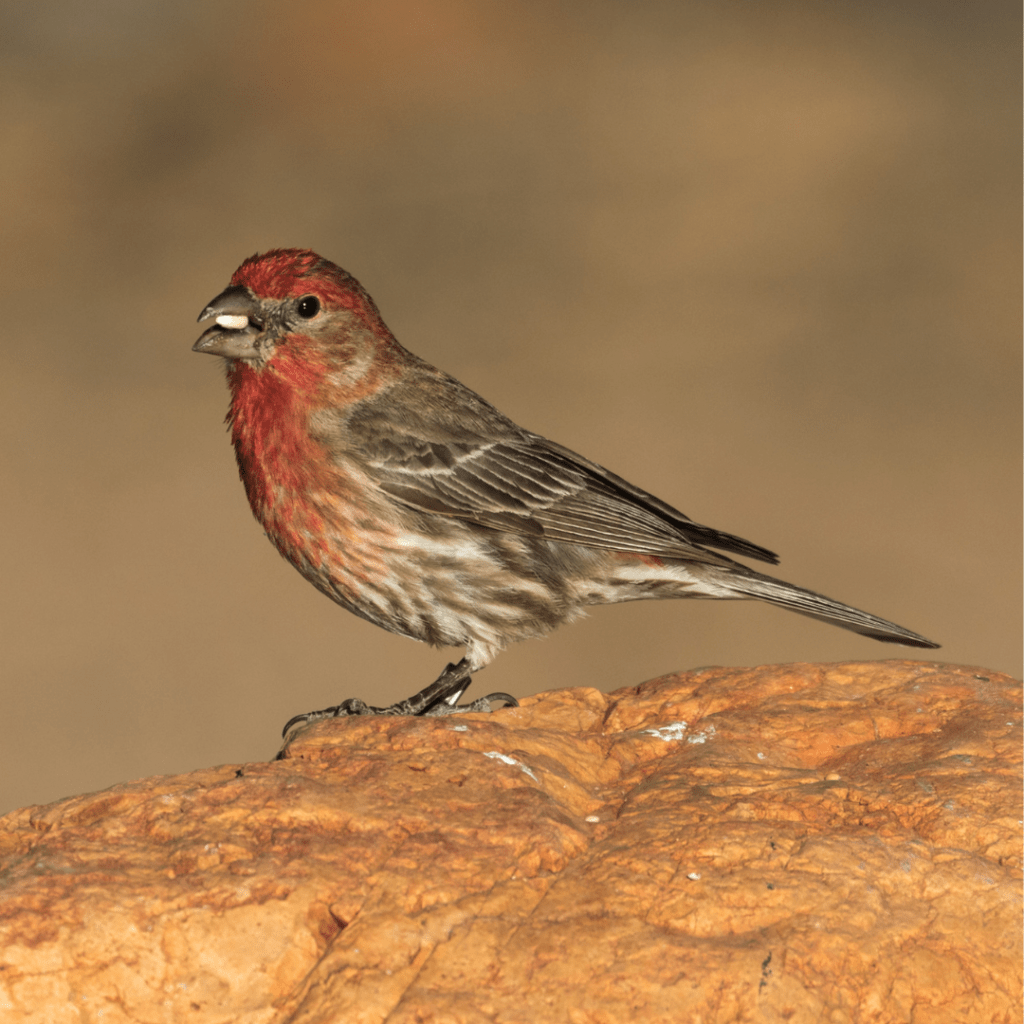
The house finch is the bird most likely to be mistaken as a “red sparrow.”
The house finch was originally a western bird. After a small number was released in New York in 1940—after a failed attempt to sell them as pets—house finches spread throughout the Eastern US.
Today, the house finch is one of the most common birds in North America, with an estimated population of over 200 million.
House finches are around 6” in length with short wings, large bills, and flat heads.
Female house finches are not red. They’re streaked brown and gray and quite difficult to tell apart from other small brown birds.
Male house finches have red heads, chests, and rumps (the spot above the tail).
Compared to the brilliant bright red of a cardinal or a scarlet tanager, a house finch’s red is duller. The soft pinkish-red blends into a house finch’s brownish back, belly, and tail. However, while the red coloring isn’t vibrant, it’s distinct enough to provide a primary identification clue.
Difference between Sparrows and Finched, How to Tell them apart!
While many species of finch are quite beautiful, others, along with most sparrows, are rather plain-looking. The plainer a bird looks, the harder it is to ID.
Some birders refer to sparrows, some finch species, and other small birds as “little brown birds” (LBBs) or “little brown jobs (LBJs). It’s easier to lump them together like that than to sort them out by picking out tiny spots of yellow or white or measuring bill sizes through binoculars.
However, with effort, you can learn to see an LBJ and determine if you’re looking at a sparrow, a finch, or something else.
Here are a few differences between sparrows and finches. Keep in mind, these descriptions are generalizations, summing up many diverse species.
Trait | New World Sparrows | Finches |
Body shape | Round and plump with longer legs | Slender with shorter legs |
Tail | Short, rounded tail | Short tail, flat or notched (fishtail shape) |
Head and bill | Head is round, bill is conical and short | Front of the head is flat, bill is conical and stubby |
Plumage | Plain colors (mostly browns and grays), but with more intricate patterns | More colorful, but with simpler patterns |
Seeds, nuts, fruits, insects | Mostly herbivorous (seeds, nuts, fruits), some insects |
Many of the small birds that confidently share our neighborhoods are various types of sparrows. However, if you’re seeing a sparrow-like bird that bears some true red coloring, your first guess should be that it’s a house finch.

Kelly is an environmental science writer, naturalist, and birdwatcher. Kelly holds a master’s degree in environmental policy and has worked as an environmental analyst, urban planner, and professor of environmental planning.

